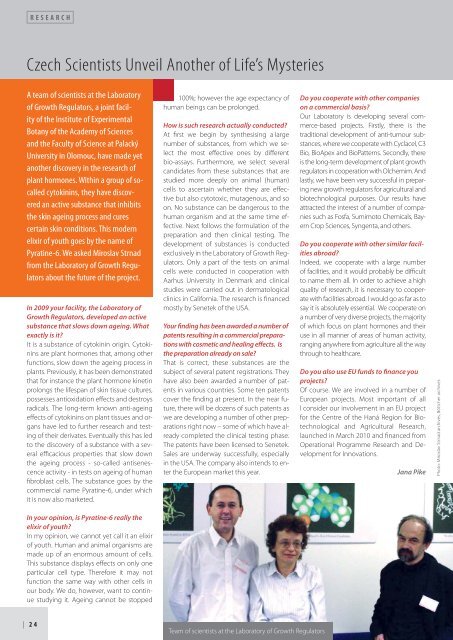czech pavilion at 2010 expo - MZV ÄŒR
czech pavilion at 2010 expo - MZV ÄŒR
czech pavilion at 2010 expo - MZV ÄŒR
Create successful ePaper yourself
Turn your PDF publications into a flip-book with our unique Google optimized e-Paper software.
| 24<br />
RESEARCH<br />
Czech Scientists Unveil Another of Life’s Mysteries<br />
A team of scientists <strong>at</strong> the Labor<strong>at</strong>ory<br />
of Growth Regul<strong>at</strong>ors, a joint facility<br />
of the Institute of Experimental<br />
Botany of the Academy of Sciences<br />
and the Faculty of Science <strong>at</strong> Palacký<br />
University in Olomouc, have made yet<br />
another discovery in the research of<br />
plant hormones. Within a group of socalled<br />
cytokinins, they have discovered<br />
an active substance th<strong>at</strong> inhibits<br />
the skin ageing process and cures<br />
certain skin conditions. This modern<br />
elixir of youth goes by the name of<br />
Pyr<strong>at</strong>ine-6. We asked Miroslav Strnad<br />
from the Labor<strong>at</strong>ory of Growth Regul<strong>at</strong>ors<br />
about the future of the project.<br />
In 2009 your facility, the Labor<strong>at</strong>ory of<br />
Growth Regul<strong>at</strong>ors, developed an active<br />
substance th<strong>at</strong> slows down ageing. Wh<strong>at</strong><br />
exactly is it?<br />
It is a substance of cytokinin origin. Cytokinins<br />
are plant hormones th<strong>at</strong>, among other<br />
functions, slow down the ageing process in<br />
plants. Previously, it has been demonstr<strong>at</strong>ed<br />
th<strong>at</strong> for instance the plant hormone kinetin<br />
prolongs the lifespan of skin tissue cultures,<br />
possesses antioxid<strong>at</strong>ion eff ects and destroys<br />
radicals. The long-term known anti-ageing<br />
eff ects of cytokinins on plant tissues and organs<br />
have led to further research and testing<br />
of their deriv<strong>at</strong>es. Eventually this has led<br />
to the discovery of a substance with a several<br />
effi cacious properties th<strong>at</strong> slow down<br />
the ageing process - so-called antisenescence<br />
activity - in tests on ageing of human<br />
fi broblast cells. The substance goes by the<br />
commercial name Pyr<strong>at</strong>ine-6, under which<br />
it is now also marketed.<br />
In your opinion, is Pyr<strong>at</strong>ine-6 really the<br />
elixir of youth?<br />
In my opinion, we cannot yet call it an elixir<br />
of youth. Human and animal organisms are<br />
made up of an enormous amount of cells.<br />
This substance displays eff ects on only one<br />
particular cell type. Therefore it may not<br />
function the same way with other cells in<br />
our body. We do, however, want to continue<br />
studying it. Ageing cannot be stopped<br />
100%; however the age expectancy of<br />
human beings can be prolonged.<br />
How is such research actually conducted?<br />
At fi rst we begin by synthesising a large<br />
number of substances, from which we select<br />
the most eff ective ones by diff erent<br />
bio-assays. Furthermore, we select several<br />
candid<strong>at</strong>es from these substances th<strong>at</strong> are<br />
studied more deeply on animal (human)<br />
cells to ascertain whether they are eff ective<br />
but also cytotoxic, mutagenous, and so<br />
on. No substance can be dangerous to the<br />
human organism and <strong>at</strong> the same time effective.<br />
Next follows the formul<strong>at</strong>ion of the<br />
prepar<strong>at</strong>ion and then clinical testing. The<br />
development of substances is conducted<br />
exclusively in the Labor<strong>at</strong>ory of Growth Regul<strong>at</strong>ors.<br />
Only a part of the tests on animal<br />
cells were conducted in cooper<strong>at</strong>ion with<br />
Aarhus University in Denmark and clinical<br />
studies were carried out in derm<strong>at</strong>ological<br />
clinics in California. The research is fi nanced<br />
mostly by Senetek of the USA.<br />
Your fi nding has been awarded a number of<br />
p<strong>at</strong>ents resulting in a commercial prepar<strong>at</strong>ions<br />
with cosmetic and healing eff ects. Is<br />
the prepar<strong>at</strong>ion already on sale?<br />
Th<strong>at</strong> is correct, these substances are the<br />
subject of several p<strong>at</strong>ent registr<strong>at</strong>ions. They<br />
have also been awarded a number of p<strong>at</strong>ents<br />
in various countries. Some ten p<strong>at</strong>ents<br />
cover the fi nding <strong>at</strong> present. In the near future,<br />
there will be dozens of such p<strong>at</strong>ents as<br />
we are developing a number of other prepar<strong>at</strong>ions<br />
right now – some of which have already<br />
completed the clinical testing phase.<br />
The p<strong>at</strong>ents have been licensed to Senetek.<br />
Sales are underway successfully, especially<br />
in the USA. The company also intends to enter<br />
the European market this year.<br />
Team of scientists <strong>at</strong> the Labor<strong>at</strong>ory of Growth Regul<strong>at</strong>ors<br />
Do you cooper<strong>at</strong>e with other companies<br />
on a commercial basis?<br />
Our Labor<strong>at</strong>ory is developing several commerce-based<br />
projects. Firstly, there is the<br />
traditional development of anti-tumour substances,<br />
where we cooper<strong>at</strong>e with Cyclacel, C3<br />
Bio, BioApex and BioP<strong>at</strong>terns. Secondly, there<br />
is the long-term development of plant growth<br />
regul<strong>at</strong>ors in cooper<strong>at</strong>ion with Olchemim. And<br />
lastly, we have been very successful in preparing<br />
new growth regul<strong>at</strong>ors for agricultural and<br />
biotechnological purposes. Our results have<br />
<strong>at</strong>tracted the interest of a number of companies<br />
such as Fosfa, Sumimoto Chemicals, Bayern<br />
Crop Sciences, Syngenta, and others.<br />
Do you cooper<strong>at</strong>e with other similar facilities<br />
abroad?<br />
Indeed, we cooper<strong>at</strong>e with a large number<br />
of facilities, and it would probably be diffi cult<br />
to name them all. In order to achieve a high<br />
quality of research, it is necessary to cooper<strong>at</strong>e<br />
with facilities abroad. I would go as far as to<br />
say it is absolutely essential. We cooper<strong>at</strong>e on<br />
a number of very diverse projects, the majority<br />
of which focus on plant hormones and their<br />
use in all manner of areas of human activity,<br />
ranging anywhere from agriculture all the way<br />
through to healthcare.<br />
Do you also use EU funds to fi nance you<br />
projects?<br />
Of course. We are involved in a number of<br />
European projects. Most important of all<br />
I consider our involvement in an EU project<br />
for the Centre of the Haná Region for Biotechnological<br />
and Agricultural Research,<br />
launched in March <strong>2010</strong> and fi nanced from<br />
Oper<strong>at</strong>ional Programme Research and Development<br />
for Innov<strong>at</strong>ions.<br />
Jana Pike<br />
Photo: Miroslav Strnad archives, Böttcher archives

















